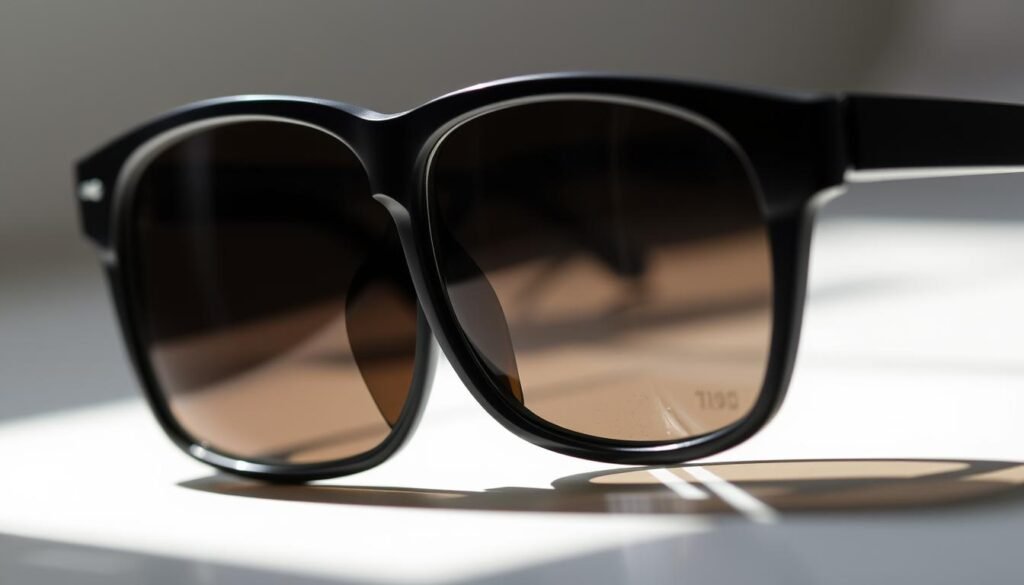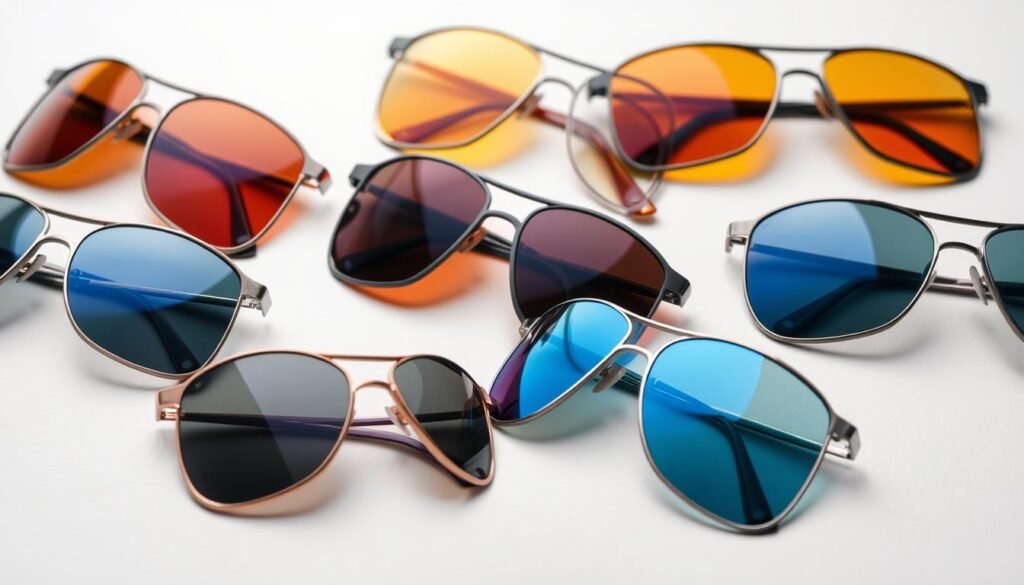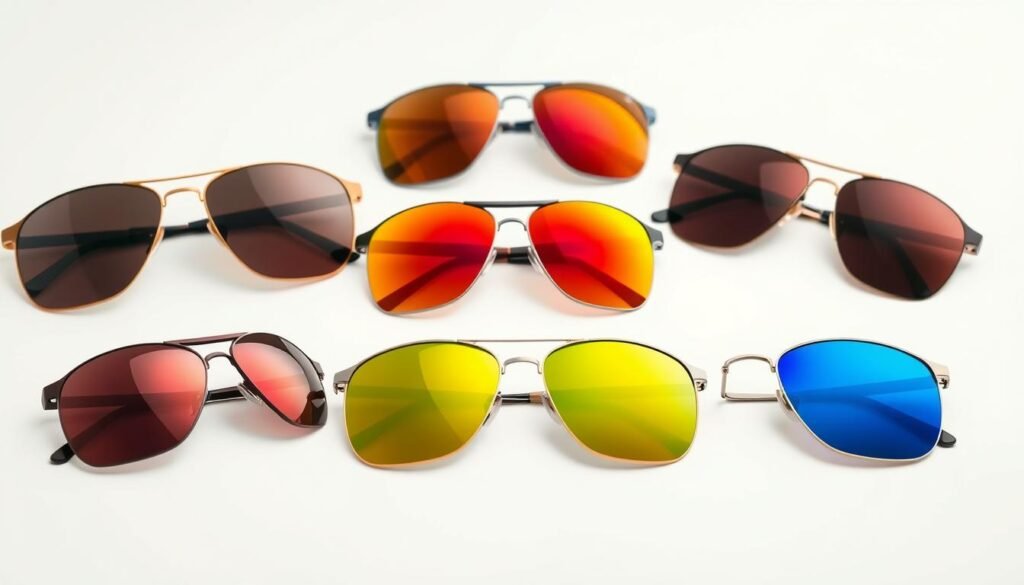Choosing the right sunglasses can be overwhelming, especially with the numerous lens options available.
When it comes to selecting the perfect sunglasses, the lens type is a critical factor. Different lenses offer various benefits, from style and functionality to protection and comfort.
Understanding the different sunglasses lens types is essential to making an informed decision. In this article, we’ll explore the various lens options and their advantages, helping you find the best lens type for sunglasses that suits your needs.
Key Takeaways
- Different lens types offer various benefits for sunglasses.
- Understanding lens options is crucial for making an informed decision.
- The right lens type can enhance style, functionality, and comfort.
- Lens type affects the overall performance of sunglasses.
- Choosing the right lens type depends on individual needs and preferences.
Understanding Sunglasses Lens Types
Choosing the right sunglasses involves more than just picking a stylish frame; it’s also about selecting the appropriate lens type. The lens you choose can significantly affect your visual comfort and eye protection. Different lens materials and technologies offer unique benefits, such as UV protection, glare reduction, and enhanced visual clarity.
Why Lens Type Matters
The type of lens you choose for your sunglasses can impact your visual experience and eye health. Different lens materials offer varying levels of protection and comfort. For instance, some lenses are designed to provide superior UV protection, while others are optimized for glare reduction or visual clarity.
Key Factors in Lens Selection
When selecting sunglasses lenses, several factors come into play. Your lifestyle, personal preferences, and specific needs all influence the ideal lens type for you. For example, if you’re an outdoor enthusiast, you may prioritize lenses that offer superior UV protection and glare reduction. On the other hand, if you’re looking for everyday wear, you might focus on lenses that provide a balance between protection and style.
Key considerations include the lens material, tint, and any additional features such as polarization or photochromic technology. By understanding these factors and how they align with your needs, you can make an informed decision when choosing your sunglasses.
The Best Lens Type for Sunglasses: A Comprehensive Guide
The best lens type for sunglasses depends on several factors, including your lifestyle, preferences, and specific needs. With so many options available, it’s essential to understand the characteristics of each lens type to make an informed decision.
Matching Lens Types to Your Needs
Different activities and lifestyles require different lens types. For instance, if you’re an outdoor enthusiast, you may prioritize lenses that offer excellent UV protection and glare reduction. On the other hand, if you spend most of your time driving, you might prefer lenses that enhance visibility and reduce glare from roads and windshields.
To help you choose the right lens type, consider the following factors:
- Your primary activities while wearing sunglasses
- The level of UV protection you need
- Your personal preferences regarding lens color and tint
- The durability and weight of the lenses
Performance Factors to Consider
When evaluating lens performance, several factors come into play. These include optical clarity, impact resistance, and the ability to reduce glare. The table below summarizes key performance factors for different lens types:
| Lens Type | Optical Clarity | Impact Resistance | Glare Reduction |
|---|---|---|---|
| Glass Lenses | Excellent | Moderate | Good |
| Polycarbonate Lenses | Good | Excellent | Good |
| CR-39 Plastic Lenses | Good | Moderate | Fair |
By considering your needs and evaluating the performance factors of different lens types, you can find the perfect pair of sunglasses that combines style, comfort, and protection.
Glass Lenses: Pros and Cons
When it comes to sunglasses, glass lenses are often considered the gold standard due to their clarity and scratch resistance. Glass lenses have been a popular choice for those seeking high-quality vision correction in their sunglasses.
Optical Clarity and Scratch Resistance
One of the primary advantages of glass lenses is their exceptional optical clarity. They provide a clear and distortion-free viewing experience, making them ideal for individuals who prioritize visual acuity. Additionally, glass lenses are known for their scratch resistance, which helps maintain their clarity over time.
However, advancements in lens technology have led to the development of various coatings that can enhance the scratch resistance of glass lenses further. For instance, applying an anti-scratch coating can significantly improve their durability.
Weight and Durability Concerns
Despite their advantages, glass lenses also have some drawbacks. One of the main concerns is their weight; glass lenses are generally heavier than lenses made from other materials, which can affect the overall comfort of the sunglasses.
Another concern is their durability. While they are scratch-resistant, glass lenses can be more prone to shattering upon impact compared to other lens materials. This can be a significant consideration for individuals who engage in high-impact activities.
| Feature | Glass Lenses | Other Lens Materials |
|---|---|---|
| Optical Clarity | Excellent | Varies |
| Scratch Resistance | High | Varies |
| Weight | Heavier | Generally Lighter |
| Durability | Prone to Shattering | More Impact-Resistant |
In conclusion, glass lenses offer excellent optical clarity and scratch resistance, making them a great choice for those who value these features. However, their weight and potential fragility are important considerations. By weighing these pros and cons, individuals can make an informed decision about whether glass lenses are the right choice for their sunglasses.
Polycarbonate Lenses: The Impact-Resistant Option
For individuals seeking durable and reliable eyewear, polycarbonate lenses offer a compelling solution. Known for their exceptional impact resistance, these lenses are ideal for people who engage in high-risk activities or require durable eyewear.
Lightweight and Shatterproof Benefits
One of the primary advantages of polycarbonate lenses is their lightweight nature, making them comfortable to wear for extended periods. Additionally, their shatterproof properties significantly reduce the risk of eye injury due to lens fragmentation.
- High impact resistance
- Lightweight for comfort
- Shatterproof for safety
Optical Quality Considerations
While polycarbonate lenses excel in terms of durability, their optical quality can be a concern. Some users may notice a slight distortion or aberration, particularly at the periphery of the lens.
To mitigate this, many manufacturers have developed advanced polycarbonate lens designs that minimize optical aberrations, ensuring clear and distortion-free vision.
CR-39 Plastic Lenses: Finding the Balance
CR-39 plastic lenses offer a unique blend of cost-effectiveness and optical quality, making them a popular choice for everyday wear and prescription sunglasses.
The benefits of CR-39 plastic lenses include their cost-effectiveness and relatively lightweight nature, enhancing wearer comfort.
Cost-Effectiveness and Weight
One of the primary advantages of CR-39 plastic lenses is their affordability without compromising on essential optical qualities. They are also lighter compared to glass lenses, making them more comfortable for extended wear.
- Affordable without sacrificing optical quality
- Lightweight, enhancing comfort
Durability and Performance
While CR-39 plastic lenses are more prone to scratches than glass or polycarbonate lenses, they still offer satisfactory durability for everyday use. Their performance is characterized by clear vision and adequate UV protection.
In summary, CR-39 plastic lenses strike a balance between cost, weight, and performance, making them a viable option for individuals seeking a practical solution for their sunglasses needs.
Polarized Lenses: Eliminating Glare
The technology behind polarized lenses is designed to eliminate glare, enhancing visual comfort. Polarized lenses are particularly beneficial for individuals who spend a significant amount of time outdoors, whether driving, fishing, or participating in water sports.
How Polarization Works
Polarization works by filtering out horizontally polarized light, which is the type of light that reflects off surfaces like water, snow, and car windshields. This is achieved through a special filter that allows only vertically polarized light to pass through, thus reducing glare.
The polarization process involves embedding a polarizing film within the lens. This film acts as a grid that blocks the unwanted light, resulting in clearer vision and reduced eye strain.
Ideal Activities for Polarized Lenses
Polarized lenses are ideal for various activities, including:
- Driving: Reduces glare from oncoming traffic and road surfaces.
- Fishing: Enhances visibility into the water by reducing glare from the surface.
- Water Sports: Improves visibility and comfort by minimizing glare from water.
Limitations of Polarized Lenses
While polarized lenses offer numerous benefits, there are some limitations to consider. For instance, they can make it difficult to read LCD screens, as the polarization can interfere with the screen’s visibility.
Additionally, polarized lenses may not be ideal for activities that require viewing certain types of reflective surfaces or screens. It’s essential to weigh these limitations against the benefits when deciding on polarized lenses.

| Activity | Benefit of Polarized Lenses | Limitation |
|---|---|---|
| Driving | Reduces glare from oncoming traffic | May interfere with certain dashboard screens |
| Fishing | Enhances visibility into the water | None significant |
| Water Sports | Improves visibility and comfort | None significant |
Photochromic Lenses: Adapting to Light Conditions
Photochromic lenses are designed to adjust their tint in response to changing light conditions, ensuring optimal vision. This adaptability makes them an excellent choice for individuals who frequently transition between indoor and outdoor environments.
Transition Technology Explained
The technology behind photochromic lenses involves molecules that change their structure in response to ultraviolet (UV) light. When exposed to UV radiation, these molecules undergo a transformation that darkens the lens, while in the absence of UV light, they revert to their original state, lightening the lens. This process allows for a seamless transition between different lighting conditions.
Performance in Different Environments
Photochromic lenses perform exceptionally well in varying light conditions. They darken in bright sunlight, reducing glare and improving visual comfort, and lighten indoors or in low-light conditions, providing optimal clarity. This adaptability makes them suitable for a wide range of activities, from driving to outdoor sports.
Limitations to Consider
While photochromic lenses offer numerous benefits, there are some limitations to consider. For instance, they may not darken as much inside a car due to the windshield blocking some UV rays. Additionally, temperature can affect their performance, with colder temperatures often resulting in faster darkening and slower lightening.
Overall, photochromic lenses provide a convenient and comfortable solution for individuals seeking adaptable eyewear. By understanding their technology and performance, you can make an informed decision about whether they are the right choice for your lifestyle.
Lens Colors and Tints: Choosing the Right Hue
Lens colors and tints play a crucial role in both the functionality and style of your sunglasses. Different tints offer unique benefits, such as glare reduction, color enhancement, or fashion statements.
Gray/Neutral Tints
Gray or neutral tints are versatile and suitable for most activities. They reduce brightness without distorting colors, making them ideal for everyday wear.
Brown/Amber Tints
Brown or amber tints enhance contrast and are particularly beneficial for activities like driving or fishing. They can also reduce eye strain.
Green Tints
Green tints are known for their comfort and are often used in sports sunglasses. They reduce glare and enhance contrast in various lighting conditions.
Yellow/Orange Tints
Yellow or orange tints are excellent for low-light conditions, enhancing contrast and visibility. They’re popular among cyclists and skiers.
Blue and Purple Tints
Blue and purple tints are more fashion-oriented but can also reduce glare. However, they may not be suitable for all activities due to color distortion.
When choosing a lens tint, consider your primary activities and personal preferences. Here’s a summary of the different tints and their ideal uses:
| Lens Tint | Ideal Use | Benefits |
|---|---|---|
| Gray/Neutral | Everyday wear | Reduces brightness, true color perception |
| Brown/Amber | Driving, fishing | Enhances contrast, reduces eye strain |
| Green | Sports | Reduces glare, enhances contrast |
| Yellow/Orange | Low-light activities (cycling, skiing) | Enhances visibility, contrast |
| Blue/Purple | Fashion, specific sports | Reduces glare, fashion statement |

Ultimately, the right lens color or tint depends on your specific needs and preferences. By understanding the benefits of each, you can make an informed decision that enhances both your visual comfort and style.
Prescription Sunglasses: Options and Considerations
Prescription sunglasses have become increasingly popular as they offer a convenient way to enjoy the outdoors without compromising on vision correction. With the advancement in lens technology, individuals now have a wide range of options to choose from.
When it comes to prescription sunglasses, one of the primary considerations is the type of lens. The choice between single vision lenses and progressive lenses depends on the individual’s specific needs. Single vision lenses are ideal for those who require correction for either near or far vision, while progressive lenses offer a more versatile solution for individuals with presbyopia, providing a seamless transition between different distances.
Single Vision vs. Progressive Lenses
Single vision lenses are straightforward and provide correction for one field of vision. Progressive lenses, on the other hand, offer multiple focal points, making them suitable for a wider range of activities.
Material Considerations for Prescription Lenses
The material of the lens is another crucial factor. Common materials include polycarbonate, Trivex, and high-index plastic, each offering different benefits in terms of weight, durability, and optical clarity.
| Material | Weight | Durability | Optical Clarity |
|---|---|---|---|
| Polycarbonate | Lightweight | High Impact Resistance | Good |
| Trivex | Lightweight | Excellent Impact Resistance | Excellent |
| High-Index Plastic | Thinner and Lighter | Good Durability | Excellent |
Cost and Insurance Factors
The cost of prescription sunglasses can vary significantly based on the lens material, type, and brand. It’s essential to check with your insurance provider to understand what is covered under your plan.
Specialized Lens Types for Different Activities
Different activities demand specialized lenses designed to enhance your performance and visual comfort. Whether you’re driving, enjoying water sports, playing golf, or simply navigating everyday urban environments, the right lenses can make a significant difference.
Driving and Road Conditions
For driving, lenses that reduce glare and improve visibility are crucial. Polarized lenses can be particularly useful, as they minimize glare from oncoming traffic and reflective surfaces. Additionally, lenses with a gray or brown tint can help reduce eye strain caused by varying light conditions on the road.
Water and Snow Sports
For water and snow sports, polarized lenses are again a great choice, as they reduce glare from the water or snow, enhancing visual clarity and comfort. Mirrored lenses can also be beneficial, as they reflect light and reduce glare. For snow sports, lenses with good UV protection are essential to prevent eye damage from the intense sunlight reflected off the snow.
Golf and Outdoor Sports
Golfers and outdoor sports enthusiasts can benefit from lenses that enhance contrast and depth perception. Amber or brown tints can improve visual clarity and help athletes track the ball more effectively. Additionally, photochromic lenses, which adjust to changing light conditions, can be useful for sports that involve varying light environments.
Everyday Urban Use
For everyday urban use, lenses that provide comfort and style are key. Gradient lenses can be a fashionable choice, offering a stylish look while providing UV protection. Additionally, lenses with a neutral tint, such as gray, can be versatile and suitable for a wide range of lighting conditions.
By choosing the right activity-specific lenses, you can enhance your visual comfort and performance across various activities. Whether you’re looking for improved glare reduction, enhanced contrast, or simply a stylish accessory, there’s a lens type designed to meet your needs.
Conclusion: Making Your Final Lens Selection
Choosing the right lens type for your sunglasses can be a daunting task, but with the information provided in this article, you’re now equipped to make an informed decision. Consider your lifestyle, preferences, and specific needs when making your final lens selection.
Whether you prioritize style, functionality, or a combination of both, the perfect lens type is out there for you. By weighing factors such as lens material, polarization, and tint, you can find the ideal sunglasses to suit your needs.
Make your final decision with confidence, knowing that the right lens selection will enhance your sunglasses experience, providing a comfortable and enjoyable wearing experience.

